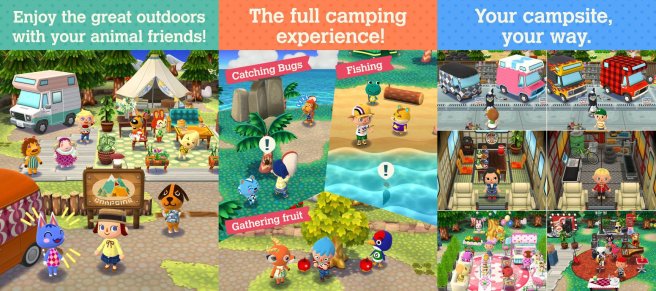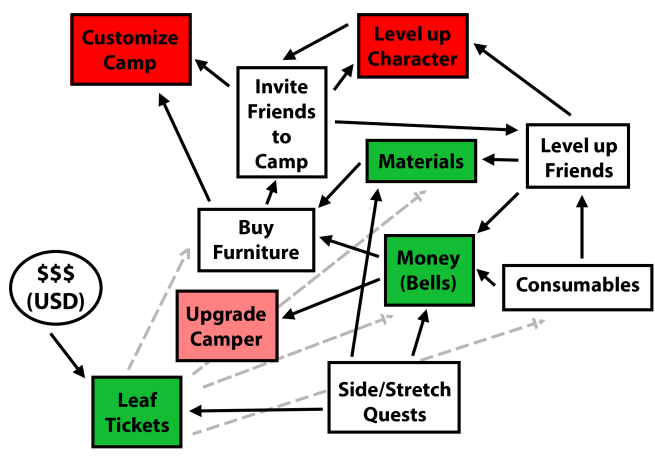
My previous post outlined how the original Animal Crossing game approached and solved the problem of a life simulator game with unprecedented freedom in a sandbox game.
Pocket Camp and Directionless Play
Lets just dive in and look at the game mechanics graph for Pocket Camp. I’ve attempted to outline all the possibilities for the game as best I could, but there might be end-game material I didn’t experience. I poured in a few day’s worth, of 20ish hours, and felt bored really fast. I only persisted for the sake of science and this review.
Game mechanics graph 2

(Red: Primary goal, Pink: secondary goal, Green: currency)
First off, the primary objective is never really defined. It isn’t as prominent in this game as the original. I’ve defined the primary goals as customizing your camp and leveling up your character. This game blends more RPG elements than the original, which changes things dramatically in my opinion. Notice the mess of game mechanics. There are now three currencies: money, materials (crafting resources), and Leaf Tickets (which are mostly bought with real money and can be used to accomplish almost anything in the game). These currencies are used to accomplish the major objectives of the game. The player seeks to acquire bells and materials so that they can buy furniture, which is necessary to invite friends to camp, while also providing the customization of your camp. Leaf tickets are also a major currency as they can accomplish almost anything in-game, and are the micro-transactions that drive the game.
Now I don’t want to spend a tirade on micro-transactions. I know that they are a hot-bed of opinion, especially with the fury over Battlefront II. Needless to say, they are an easy addition to Pocket Camp and don’t necessarily detract from the game play.
But coming back to this game play mechanics graph: it is a real mess. Too many mechanics, too many currencies, and too many options. While the original game embraced an open-ended nature that continues to pervade in the series, that freedom was still easily reduced and simplified. In Pocket Camp there are too many various things to do, too much stuff to collect, too much stuff to trade for more stuff. Which brings me to the root of the problem with Pocket Camp, it doesn’t know what it wants to be.
All good games can be summed up in a short sentence. Monopoly is a game of bankrupting your opponents, Risk is a game of conquering the world. But what is Pocket Camp? After a lot of meditation, I feel that the game’s purpose is to “collect stuff.” Think about it, everything you do is going out to collect more materials, more consumables, more money, more furniture, more friends, etc. It is a consumeristic game, which isn’t necessarily a bad thing, but because it is so focused on the next shiny thing, it doesn’t improve the game play or experiences of the player.
Even the map of the game showcases this hoarding mentality: the player travels to various locations on the outskirts of their camp, collecting items and friends, that are then brought back to the hub location. But what is the most important stuff for a player to collect? Should they be collecting consumables? Should they be collecting friends? What do they do after they collect friends? Should they be constantly leveling up their friends or just chasing the shiny new ones? These questions arise from the player when they are dropped into the universe of Pocket Camp, and even after mapping out the game mechanics I am no closer to discovering the purpose of this game.
So What
These weaknesses, of not having a clear objective and a defined purpose, arise from the genre and form of the game. While I am not completely against the mobile gaming platform, when the Animal Crossing game was adapted to mobile it took some of the problems associated with the genre. Unlike the objective-driven games native to home consoles, most mobile games try to muddle the end game as much as possible. Mobile games are not in the business of having users finish their games, they want the experience to continue ad infinitum.
But with the original game, Animal Crossing paved the way for recurring objectives. Like arcade games that increase the difficulty via algorithms, these recurring and moving goals meet the needs of the player and the developer. Not only does the player have something that they are working towards, the developer can keep moving that finish line so that the game feels longer and more involved. However, Pocket Camp instead tries to tap into infinity play by muddling the game play. And then Pocket Camp tries to promote microtransactions by creating too many currencies, which then also convolute game play by making anything possible with enough money.
And lastly, Pocket Camp tries to tap into the trends of this genre by implementing crafting to the game. Originally, players just bought furniture with money. If it was in the store, the player could buy it. However, the game mechanic of crafting has become very popular within mobile games. The crafting mechanic is suitable for mobile games because it creates a need within players to investigate to find what is necessary for the recipe, as well as satisfying a desire to create and customize a space. The furniture crafting in Pocket Camp inflates the currencies of the game needlessly, again convoluting the objectives and end goals of the game.
Mobile games don’t have to fit into the pitfalls of the genre. Mobile games don’t need the abundance of options caused by so many game mechanics. As a mobile game there is a right and wrong way to do infinity play. And crafting for the sake of crafting doesn’t add anything to a mobile game.
In short, here is my review of the game:
Has elements of fun, but is hindered by game mechanics and unclear objectives. I would rate 1.5/5 hearts.


One thought on “Mobile Gaming and Animal Crossing (Review: Part 2)”